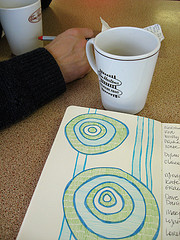I have recently been diagnosed with a rodent ulcer on my chest that will need surgery…or will it? I am unsure what affirmation to use in this instance. Do you have any suggestions on phrases that I should use?
 photo by pneff |
There are three really good questions here. Let’s look at them one at a time.
Will I need surgery or should I use EFT/Tapping?
To be honest I have no idea. I am not a medical doctor and am not qualified to advise you in this way, but I would offer this thought.
I am very excited by the many strides that have been made in complementary medicine over the last few decades. We’ve learned so much about how the body gets sick and how it heals itself. Even more exciting is the fact that we are just scratching the surface with the human body’s potential, especially its ability to heal.
That being said, I do NOT believe that complementary medicine is the best or only treatment for every situation. There are many ways of helping the body back to full health, which include medical procedures and techniques. When I bleed, the first thing I do is reach for something to stop the bleeding. Once the bleeding is under control, I will then spend time tapping to help the healing process.
The important point is that you take control and responsibility for your body. Get all of the information you can from as many trusted sources as you can. Weigh all your options and choose the course that makes the most sense for you. There are people who will approach your situation using only a surgical/pharmacological approach. Others will use only acomplementary medicine approach. Still others will use a combination of the two. There is no one right answer that can be applied to every situation.
The nice thing about EFT is it only costs you a small amount of time to do and won’t make things worse. This makes it very easy to add to any other action you decide to take.
Can my friends do EFT at a distance for me, and will it help?
When EFT is done on one person for another person (be they present or a long distance away), it’s called surrogate tapping. Describing surrogate tapping and the best way to do it is a topic that requires many an article unto itself (see all surrogate tapping resources) . But I would offer this…
When I explain surrogate tapping, especially to parents who want to tap for their children, I say, “Surrogate tapping might work, and it might not. If you choose to set 7 minutes a day aside to tap for your child, you will be spending 7 minutes thinking loving healing thoughts for your child. Even if the tapping does nothing for your child I believe that’s time well spent.”
There is a library of anecdotal evidence suggesting that surrogate tapping can be effective. If you have friends who know EFT and are willing to take some time to tap for you, I say go for it.
Again, the worst thing that will come of it is your friends will spend time thinking of you in a loving, healing way. Everything else that comes from their time and effort is a bonus.
What tapping phrases should I use for my serious medical issue?
This is the second most common question asked of an EFT practitioner (right after, “Will EFT work on…?”).
The words we use while doing EFT are not Magic. They are reminder phrases with the sole purpose of keeping us tuned into the issue at hand. There is no right or wrong way to come up with these phrases. More important than the phrases we use is the issue that we are tuning into. This is the place that we do the work.
In the circumstance of a serious health concern there are two places that I would start.
First, I would start with the emotions that you feel about your current situation. Often when we receive a medical diagnosis most of our thoughts are turned to how we are going to heal the body and cope with the situation. We frequently forget about our emotional health.
The energy we expend feeling angry, frustrated, overwhelmed, and/or frightened — and all of these emotions are commonly associated with major health concerns — take energy away from the body’s immune system and the healing process. It is extremely important to release these emotions. We are going to have a clearer mind to make the choices that are right for us, and we are going have the body’s full reserve of energy committed to the healing process.
Some of the most common emotions associated with health issues that are worth tapping on are:
- anger (at self for letting happen, for not getting the care you deserver, at it not being fair)
- fear (of death, of debilitation, of never being whole again, of being dependant on others, of getting worse, of being a burden to others, of not being able to heal, of not knowing what to do)
- frustration (that you have no control, that you did everything you could and it still happened, that is cost so much to deal with)
- sadness
- loss (of mobility, of health, of freedom, of youth, of activities)
By spending time clearing these emotions we can’t help but feel better, have a clearer mind to make choices about our care, and have the full store of our energy committed to healing. I truly believe this is a very important (and often overlooked) step in the healing process. Second, I would spend time with the symptoms themselves, which is what the main question is about. I have written on this topic before.
If you are interested in seeing how to approach the symptoms themselves check out: The Body Has Information About Our Issues 3 Easy Ways to Approach Physical Issues
I know I sound like a broken record, but the words are not magic. The important thing is focus. The two articles above will show you great ways to tune into what is going on in your body, giving you words that will help you tune into the issue at hand.












